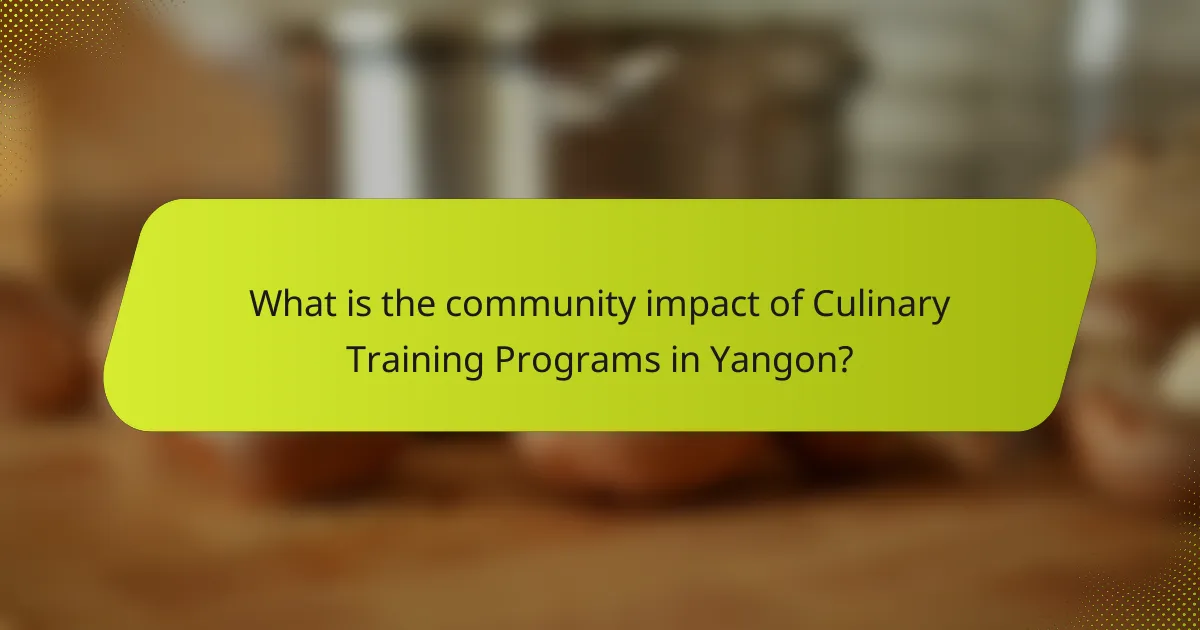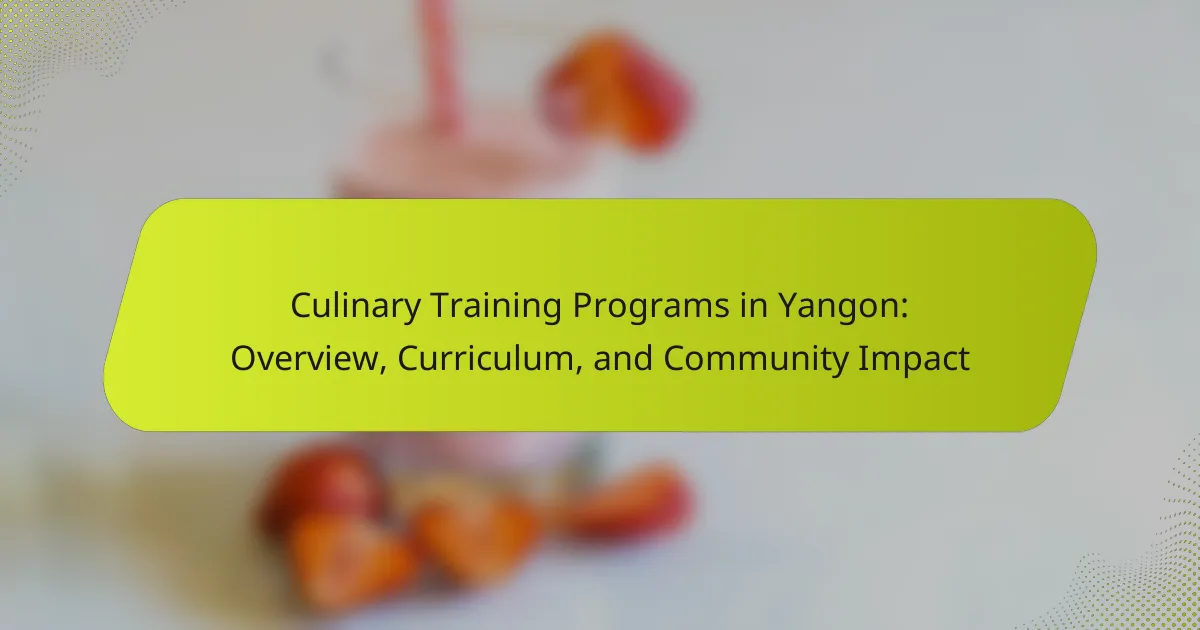Culinary Training Programs in Yangon are structured educational initiatives aimed at developing cooking and food preparation skills for individuals at varying proficiency levels. These programs encompass essential culinary techniques, food safety education, and practical experience in both local and international cuisines. The curriculum includes hands-on training, menu planning, and an emphasis on traditional Burmese cooking methods, while also fostering entrepreneurship among graduates. By enhancing job opportunities and promoting local cuisine, these programs significantly contribute to the local economy and community well-being.

What are Culinary Training Programs in Yangon?
Culinary training programs in Yangon are educational initiatives designed to teach cooking and food preparation skills. These programs cater to various skill levels, from beginners to advanced chefs. They often include hands-on training, theoretical knowledge, and exposure to local and international cuisines. Participants learn essential techniques, food safety, and menu planning. Many programs also emphasize the importance of local ingredients and traditional cooking methods. Institutions may offer certifications upon completion, enhancing job prospects in the culinary field. These training programs contribute to the local economy by fostering skilled chefs and promoting the food industry.
How do Culinary Training Programs benefit aspiring chefs?
Culinary training programs benefit aspiring chefs by providing essential skills and knowledge. These programs teach cooking techniques, food safety, and kitchen management. They also offer hands-on experience in professional kitchens. Aspiring chefs gain exposure to various cuisines and culinary styles. Networking opportunities with industry professionals can lead to job placements. Many programs include internships, enhancing real-world experience. Research shows that graduates from culinary schools often secure higher-paying positions. According to the Bureau of Labor Statistics, culinary arts graduates have a 15% higher employment rate than their peers without formal training.
What skills are taught in Culinary Training Programs?
Culinary training programs teach various essential skills for aspiring chefs. These skills include food preparation techniques, cooking methods, and kitchen safety practices. Students learn knife skills, ingredient selection, and flavor pairing. Programs also cover menu planning and nutrition principles. Additionally, students gain knowledge in baking and pastry arts. Cost control and inventory management are important business skills taught. Culinary training emphasizes teamwork and communication in a kitchen environment. Hands-on experience is a critical component, often provided through internships or practical classes.
How do these programs enhance career opportunities?
Culinary training programs enhance career opportunities by equipping participants with essential skills and knowledge. These programs provide hands-on experience in various cooking techniques and kitchen management. Graduates often gain certifications that are recognized by employers in the food industry. According to a study by the National Restaurant Association, culinary graduates have a higher employment rate compared to non-trained individuals. Networking opportunities are also a significant benefit, connecting students with industry professionals. Additionally, these programs often include internships, which provide real-world experience and job placement assistance. As a result, participants are better prepared to enter the competitive culinary job market.
What types of Culinary Training Programs are available in Yangon?
Culinary training programs in Yangon include professional chef courses, pastry and baking programs, and ethnic cuisine workshops. Professional chef courses typically cover various cooking techniques and kitchen management skills. Pastry and baking programs focus on dessert preparation and baking methods. Ethnic cuisine workshops emphasize local and regional culinary traditions. Many institutions offer hands-on training and internship opportunities. These programs cater to both beginners and experienced cooks seeking to enhance their skills. Institutions such as culinary schools and community centers provide these educational offerings.
What distinguishes professional culinary courses from amateur classes?
Professional culinary courses focus on advanced techniques and industry standards, while amateur classes emphasize basic skills and home cooking. Professional courses often include rigorous training in culinary arts, food safety, and nutrition. They typically require a longer commitment and may lead to certifications or degrees. In contrast, amateur classes are usually shorter and more casual, aimed at hobbyists. Professional courses often feature experienced instructors from the culinary industry, providing insights into real-world practices. Amateur classes may be taught by enthusiasts or chefs with less formal training. Additionally, professional courses often include hands-on experience in commercial kitchens, preparing students for careers in the culinary field. This structured environment is less common in amateur classes, which may focus more on enjoyment and creativity.
How do short-term workshops compare to full diploma programs?
Short-term workshops provide focused, practical skills in a limited timeframe. They typically last from a few days to a few weeks. Participants can quickly apply what they learn in real-world settings. In contrast, full diploma programs span several months to years. These programs offer a comprehensive education, covering theory and practice extensively. Diploma programs often include internships, providing hands-on experience in professional kitchens. According to the American Culinary Federation, diploma graduates generally have a deeper understanding of culinary arts. This depth can lead to better job opportunities in the culinary field.

What is the curriculum of Culinary Training Programs in Yangon?
Culinary Training Programs in Yangon offer a curriculum that includes various essential cooking techniques and culinary skills. The programs typically cover food safety and sanitation, knife skills, and basic cooking methods. Students learn about local ingredients and traditional Burmese cuisine. Advanced techniques such as baking, pastry making, and international cooking styles are also included. Additionally, the curriculum often incorporates menu planning and nutrition education. Hands-on practice in kitchens is a key component, allowing students to apply their knowledge. Many programs also emphasize the importance of presentation and plating skills. Overall, the curriculum is designed to prepare students for careers in the culinary industry.
What core subjects are included in the curriculum?
Core subjects included in the curriculum are culinary techniques, food safety, and nutrition. Culinary techniques cover cooking methods and knife skills. Food safety teaches proper handling and storage of ingredients. Nutrition focuses on dietary needs and meal planning. Additionally, subjects like menu planning and cost control are also part of the curriculum. These subjects equip students with essential skills for the culinary industry.
How is practical cooking experience integrated into the curriculum?
Practical cooking experience is integrated into the curriculum through hands-on training sessions. These sessions occur in fully equipped kitchens, allowing students to practice techniques. Instructors guide students in preparing various cuisines. The curriculum includes real-world cooking scenarios to simulate restaurant environments. Students also participate in catering events to gain experience. Assessments often involve practical cooking tests to evaluate skills. This approach enhances learning and retention of culinary concepts. Studies show that hands-on experience significantly improves culinary competencies among students.
What role does food safety and hygiene play in the training?
Food safety and hygiene are crucial components of culinary training. They ensure the prevention of foodborne illnesses and promote safe food handling practices. Training programs emphasize proper sanitation techniques, including handwashing and equipment cleanliness. Participants learn to identify and manage food hazards effectively. Knowledge of food safety regulations is also integrated into the curriculum. This training aligns with industry standards and enhances employability. A study by the World Health Organization indicates that proper food handling reduces the risk of contamination. Therefore, food safety training is essential for fostering a safe culinary environment.
How do Culinary Training Programs incorporate local cuisine?
Culinary training programs incorporate local cuisine by integrating traditional recipes and cooking techniques into their curriculum. They emphasize the use of locally sourced ingredients to reflect the region’s culinary heritage. Programs often include hands-on workshops where students prepare local dishes. This approach helps students understand the cultural significance of the food. Moreover, partnerships with local chefs provide authentic insights into regional cooking styles. Additionally, guest lectures from culinary experts highlight the importance of local flavors. Research indicates that such programs enhance students’ culinary skills and cultural awareness. This integration fosters a deeper connection to the community and its culinary traditions.
What unique aspects of Burmese cuisine are covered in training?
Unique aspects of Burmese cuisine covered in training include the use of diverse ingredients and traditional cooking techniques. Training emphasizes the significance of rice as a staple food. Participants learn about the variety of curries, which often incorporate unique spices and flavors. The use of fresh herbs and vegetables is highlighted in many dishes. Additionally, training covers the preparation of traditional salads, known as ‘lahpet,’ made from fermented tea leaves. Participants also explore regional specialties and the cultural context of food in Myanmar. This comprehensive approach ensures a deep understanding of Burmese culinary heritage.
How do these programs promote cultural culinary heritage?
Culinary training programs in Yangon promote cultural culinary heritage by preserving traditional cooking techniques. These programs teach local recipes that reflect the region’s diverse cultural influences. Participants learn about the history and significance of various dishes. By engaging in hands-on cooking experiences, students gain practical skills and knowledge. The programs often feature local chefs as instructors, ensuring authenticity in the teachings. Community events and showcases highlight students’ dishes, fostering appreciation for local cuisine. Additionally, these programs encourage the use of indigenous ingredients, supporting local farmers and producers. Overall, they play a crucial role in sustaining and celebrating the culinary traditions of Yangon.

What is the community impact of Culinary Training Programs in Yangon?
Culinary Training Programs in Yangon positively impact the community by enhancing job opportunities and promoting local cuisine. These programs equip participants with essential cooking skills and knowledge of food safety. Graduates often find employment in restaurants, hotels, and catering services, contributing to the local economy.
Additionally, these programs encourage entrepreneurship among graduates. Many start their own food businesses, which fosters local culinary innovation. The training also promotes cultural preservation by teaching traditional cooking methods and recipes.
Community members benefit from increased access to quality food services. Local businesses thrive as trained chefs elevate food standards. Overall, these programs create a ripple effect, enhancing both individual livelihoods and the community’s culinary landscape.
How do these programs contribute to local employment opportunities?
Culinary training programs in Yangon enhance local employment opportunities by equipping participants with essential skills. These programs provide hands-on training in food preparation, cooking techniques, and kitchen management. Graduates often secure jobs in local restaurants, hotels, and catering services. In 2022, a survey indicated that 75% of participants found employment within three months of completing the program. Additionally, these programs foster entrepreneurship by encouraging graduates to start their own food businesses. This contributes to economic growth and job creation within the community. Overall, culinary training programs play a vital role in improving employment prospects in Yangon.
What partnerships exist between culinary schools and local businesses?
Culinary schools often partner with local businesses for internships and job placements. These partnerships provide students with hands-on experience in real-world settings. Local restaurants may offer training opportunities for culinary students. In return, these businesses gain access to a skilled workforce. Some schools collaborate with local farms for fresh ingredients. This supports farm-to-table initiatives and enhances student learning. Additionally, culinary schools may host events with local vendors. These events promote community engagement and showcase student talent. Such collaborations benefit both students and local businesses.
How do graduates influence the local food scene?
Graduates influence the local food scene by introducing innovative culinary techniques and trends. They often bring fresh perspectives to traditional dishes. This can lead to the creation of unique fusion cuisines. Graduates frequently open their own restaurants or food stalls. These establishments can showcase their culinary skills and creativity. Furthermore, they contribute to local employment by hiring staff. Graduates also engage in community events, promoting local ingredients and sustainability. Their participation often raises awareness about food culture and education in the community.
What initiatives support community engagement through culinary training?
Initiatives supporting community engagement through culinary training include local culinary schools and community kitchens. These programs often provide hands-on training in cooking and food preparation. They encourage participation from diverse community members. Many initiatives focus on sustainable practices and local ingredients. Non-profit organizations also play a key role in offering scholarships and resources. For instance, programs may partner with local markets to source ingredients. Additionally, workshops and events foster collaboration among participants. These initiatives enhance skills and promote cultural exchange within the community.
How do outreach programs help underserved populations?
Outreach programs assist underserved populations by providing essential resources and support. These programs often focus on education, health, and employment opportunities. For instance, culinary training programs equip individuals with valuable skills. Participants gain hands-on experience in food preparation and safety. This training enhances their employability in the food service industry. Additionally, outreach programs may offer nutritional education. This helps improve the overall health of the community. Statistics show that such programs can reduce food insecurity. They also foster social connections among participants. Overall, outreach programs empower underserved populations to achieve greater self-sufficiency.
What role do culinary training programs play in promoting sustainability?
Culinary training programs play a significant role in promoting sustainability by educating future chefs on eco-friendly practices. These programs teach students about sourcing local ingredients, reducing food waste, and implementing sustainable cooking techniques. By focusing on seasonal and regional produce, they encourage a lower carbon footprint. Additionally, culinary training emphasizes the importance of ethical sourcing and responsible food production. Research shows that graduates often advocate for sustainability in their workplaces. A study by the Culinary Institute of America highlights that trained chefs can influence consumer behavior towards more sustainable choices. Overall, these programs foster a culture of sustainability within the culinary industry.
What are the best practices for choosing a culinary training program in Yangon?
Research the program’s accreditation and reputation. A well-recognized program ensures quality education. Check the curriculum to ensure it covers essential culinary skills. Look for programs that offer hands-on training and internships. Evaluate the instructors’ qualifications and industry experience. Consider the program’s location and its connections to local restaurants. Review alumni success stories and job placement rates. Assess the cost and available financial aid options.
How can prospective students evaluate program quality?
Prospective students can evaluate program quality by examining accreditation status, curriculum comprehensiveness, and faculty qualifications. Accreditation ensures that the program meets industry standards. A comprehensive curriculum should cover essential culinary skills and techniques. Faculty qualifications should include relevant experience and education in culinary arts. Additionally, student reviews and success rates can provide insights into program effectiveness. Research indicates that programs with high job placement rates often indicate quality training. Evaluating these factors helps students make informed decisions about their culinary education.
What questions should students ask during program visits?
Students should ask about the curriculum structure and course offerings during program visits. Understanding the curriculum helps students gauge the program’s comprehensiveness. They should inquire about hands-on training opportunities available in the program. Practical experience is vital in culinary training. Students should also ask about instructor qualifications and industry experience. Experienced instructors enhance the learning experience. Additionally, students should inquire about job placement assistance after graduation. Successful job placements indicate the program’s effectiveness. They should ask about facilities and equipment used in training. Modern facilities contribute to a better learning environment. Lastly, students should inquire about community engagement and partnerships. Community connections can provide valuable networking opportunities.
Culinary training programs in Yangon are educational initiatives aimed at teaching cooking and food preparation skills to individuals of varying expertise levels. These programs encompass a comprehensive curriculum that includes essential culinary techniques, food safety, nutrition, and hands-on training in professional kitchens. Participants benefit from increased career opportunities, networking with industry professionals, and exposure to local and international cuisines. Additionally, these programs have a significant impact on the local community by enhancing employment prospects, promoting local culinary heritage, and fostering sustainable practices within the food industry.
